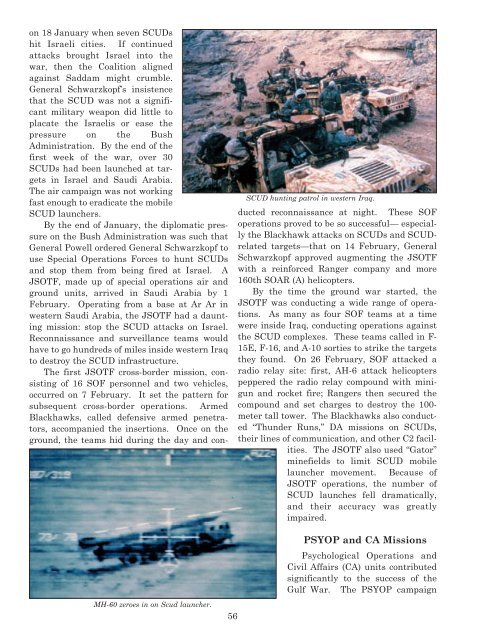HQ$History - United States Special Operations Command
HQ$History - United States Special Operations Command
HQ$History - United States Special Operations Command
Create successful ePaper yourself
Turn your PDF publications into a flip-book with our unique Google optimized e-Paper software.
SCUD hunting patrol in western Iraq.<br />
on 18 January when seven SCUDs<br />
hit Israeli cities. If continued<br />
attacks brought Israel into the<br />
war, then the Coalition aligned<br />
against Saddam might crumble.<br />
General Schwarzkopf’s insistence<br />
that the SCUD was not a significant<br />
military weapon did little to<br />
placate the Israelis or ease the<br />
pressure on the Bush<br />
Administration. By the end of the<br />
first week of the war, over 30<br />
SCUDs had been launched at targets<br />
in Israel and Saudi Arabia.<br />
The air campaign was not working<br />
fast enough to eradicate the mobile<br />
SCUD launchers.<br />
By the end of January, the diplomatic pressure<br />
on the Bush Administration was such that<br />
General Powell ordered General Schwarzkopf to<br />
use <strong>Special</strong> <strong>Operations</strong> Forces to hunt SCUDs<br />
and stop them from being fired at Israel. A<br />
JSOTF, made up of special operations air and<br />
ground units, arrived in Saudi Arabia by 1<br />
February. Operating from a base at Ar Ar in<br />
western Saudi Arabia, the JSOTF had a daunting<br />
mission: stop the SCUD attacks on Israel.<br />
Reconnaissance and surveillance teams would<br />
have to go hundreds of miles inside western Iraq<br />
to destroy the SCUD infrastructure.<br />
The first JSOTF cross-border mission, consisting<br />
of 16 SOF personnel and two vehicles,<br />
occurred on 7 February. It set the pattern for<br />
subsequent cross-border operations. Armed<br />
Blackhawks, called defensive armed penetrators,<br />
accompanied the insertions. Once on the<br />
ground, the teams hid during the day and conducted<br />
reconnaissance at night. These SOF<br />
operations proved to be so successful— especially<br />
the Blackhawk attacks on SCUDs and SCUDrelated<br />
targets—that on 14 February, General<br />
Schwarzkopf approved augmenting the JSOTF<br />
with a reinforced Ranger company and more<br />
160th SOAR (A) helicopters.<br />
By the time the ground war started, the<br />
JSOTF was conducting a wide range of operations.<br />
As many as four SOF teams at a time<br />
were inside Iraq, conducting operations against<br />
the SCUD complexes. These teams called in F-<br />
15E, F-16, and A-10 sorties to strike the targets<br />
they found. On 26 February, SOF attacked a<br />
radio relay site: first, AH-6 attack helicopters<br />
peppered the radio relay compound with minigun<br />
and rocket fire; Rangers then secured the<br />
compound and set charges to destroy the 100-<br />
meter tall tower. The Blackhawks also conducted<br />
“Thunder Runs,” DA missions on SCUDs,<br />
their lines of communication, and other C2 facilities.<br />
The JSOTF also used “Gator”<br />
minefields to limit SCUD mobile<br />
launcher movement. Because of<br />
JSOTF operations, the number of<br />
SCUD launches fell dramatically,<br />
and their accuracy was greatly<br />
impaired.<br />
MH-60 zeroes in on Scud launcher.<br />
56<br />
PSYOP and CA Missions<br />
Psychological <strong>Operations</strong> and<br />
Civil Affairs (CA) units contributed<br />
significantly to the success of the<br />
Gulf War. The PSYOP campaign

















